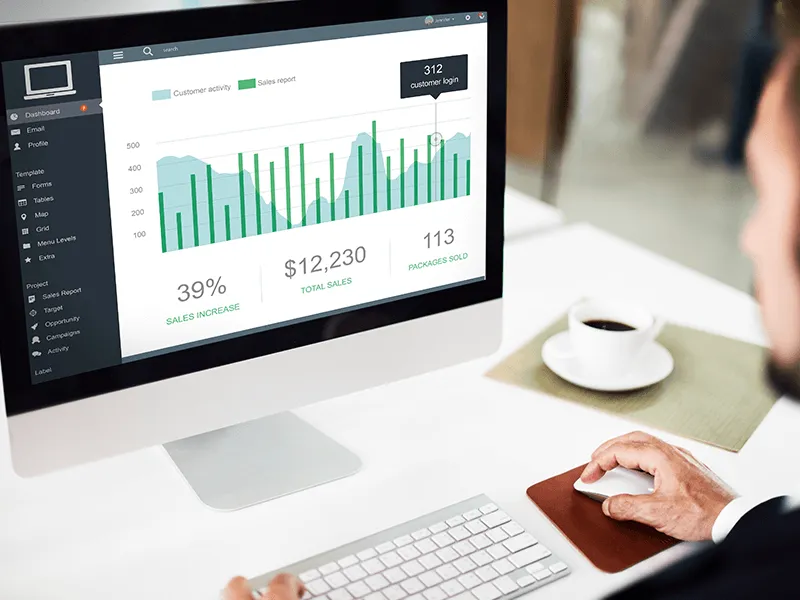2023 is almost here.
How are you planning to succeed?
You surely can’t keep on doing the same and expect different results. But you can take the magical touch of technology to make way for more efficiency and productivity in your business.
How would you do that?
You can bring transformation with the incorporation of Artificial Intelligence and Machine Learning .
For enterprises and businesses seeking an actual happy new year for their business in 2023, we have compiled the best of the AI and ML trends.
Since you are here, then you are interested in what the future holds for Artificial Intelligence and Machine Learning. Here are the top Artificial Intelligence Trends as well as Machine Learning Trends for 2023 and for the coming year.
Hyperautomation:

As per a study by Gartner, companies are likely to reduce their operational costs by at least 30% through the combination of hyperautomation technologies.
The hype encircling hyperautomation is for real. As organizations are experiencing a resource-starved ecosystem, hyperautomation is empowering processes and drawing efficiency. So, if we talk about the top AI and ML trends for 2023, their applications in hyperautomation are paving the way to transform legacy processes to optimize resource efficiency.
Leading enterprises leverage hyperautomation to keep up with the demand and bridge the supply gap to match the needs of customers. In addition to this, outdated processes lead to latency, which translates into deep losses for businesses. As a result, enterprises view hyperautomation as the ultimate instrument to survive and succeed in their industry in 2022 and beyond.
AI and ML Trends: Benefits in Hyperautomation
- Take quicker and better business decisions.
- Produce quality products and improve the time to market.
- Maximize workflow allocation by automating mundane tasks.
- Enhance agility through quicker and richer insights for decision-making with high precision.
- Decrease overall cost by cutting down resources allocated for manual intervention.
Top Industries Prospering with AI and ML through Hyperautomation
- Why Use Hyperautomation in Healthcare?
Contractual obligations, repetitive processes, piles of paper, and regulations to comply with slowdown the true momentum with which the healthcare enterprises can move ahead. However, hyperautomation developed with NLP can facilitate cost reduction, offer high quality, and turn the processes speedy. - Why Use Hyperautomation for Industrial Applications?
Hyperautomation is deemed the second industrial revolution. Hyperautomation technologies and business process management enable production facilities to develop higher quality products at a large scale. Numerous industrial ecosystems can incorporate hyperautomation to win over their legacy systems. - Why Use Hyperautomation in Finance?
Given numerous transactions, calculations, as well as communications going on with the internal team, customers, fund managers, brokers, and similar entities, the complexity is likely to increase. However, hyperautomation with optical character recognition can ensure high-quality outcomes.
Did you know?
A cohort of enterprises struggles to measure success and create tangible plans even after the incorporation of hyperautomation.
Cybersecurity

Nearly 52% of individuals trust cybersecurity when it comes to sharing their personal information online, owing to the robust AI technologies.
Cybersecurity is the digital lock to your customers’ and company’s private information. We have seen numerous cases of data breaches, intentional or unintentional, which has led to billions of dollars worth of loss. In such a situation, cybersecurity through intelligent machines can detect, analyze, and prevent your data from cyber-attacks. Despite being at the disposal of digital businesses for some time now, cybersecurity has become more powerful through its blend with AI & ML technologies.
As per a study by TechRepublic, a mid-level enterprise receives alerts for over 200,000 cyberattacks per day. Even though you employ a large team of security experts, dealing with the increasing number of cyber threats is simply difficult, if not impossible. As a result, cybersecurity developed with AI can deal with multiple threats based on priority and leave no room or leak for attacks to set in.
AI and ML Trends: Benefits in Cybersecurity
- Cybersecurity developed with AI leverages its improved network security over time to track the behavior of a network over time to identify any inconsistency.
- Cybersecurity solutions developed with AI can manage a massive amount of traffic and data.
- The time and cost taken to address a threat by AI are quite low as compared to that taken by security personnel to address the same threat.
Top Industries Tapping Into the Potential of AI and ML with Cybersecurity
- Why Use Cybersecurity in Retail?
Hackers can turn out to be opportunistic and optimistic shoppers. Owing to the growing pressure on retail enterprises, diversification of services and products takes place. As a result, retailers often neglect the security part, which can be better addressed with the integration of Artificial Intelligence and Machine Learning with cybersecurity solutions. - Why Use Cybersecurity in Manufacturing?
Falling short of assessing risks in the manufacturing business can be hazardous to human resources as well as data. In order to narrow down this gap, manufacturing companies can rely on enterprise solutions for securing their businesses through cybersecurity solutions built with AI and ML. - Why Use Cybersecurity in Government Services?
Vulnerabilities in government processes and systems can put the nation at high risk from foreign sources. Despite having the best talents as security personnel, the overall time and resources spent tackling such issues can be reduced rather with cybersecurity.
IoT

As per a study by Statista, the installed base of IoT devices is anticipated to be nearly 30.9 Bn units by 2025.
The Internet of Things uses artificial intelligence to gather data about a process and work accordingly without any manual intervention. The real-time data recorded by devices is sent to the other end and is filtered out on the basis of relevance. AI uses three phases to stimulate intelligence–learning, reasoning, and perceiving. All the connected devices use this principle to offer real-time information and act accordingly.
AI and ML Trends: Benefits in IoT
- Machine learning, as well as deep learning algorithms set with connected devices, enable better prediction and forecasting of futuristic events.
- With better insights into the systems, AI with IoT can reduce the impact of unplanned downtime.
- AI enables learning customers’ preferences in a better manner for enterprises to gather relevant information and cater to the needs of their customers.
- Real-time insights offered by IoT devices can raise red flags in case there is an inconsistency in the routine process.
Top Industries Using AI and ML with the Internet of Things
- Why Use the Internet of Things for Traffic Monitoring?
Traffic congestion is one of the leading challenges encountered by governments across the globe. In such a case, effective management and monitoring of traffic through drones and smart traffic lights can make traffic management more seamless. - Why Use the Internet of Things for the Automotive Industry?
Given the current boom towards self-driving cars, the Internet of Things can help the automotive sector to make human-based decisions through sensors from different parts. In addition to this, the internal conditions such as temperature and lighting of an automobile can also be managed autonomously through automation solutions for automotive. - Why Use the Internet of Things for the Retail Industry?
Retail solutions are crucial use cases for the Internet of Things. Based on the retail analytics, retailers can observe increase and decrease in productivity of staff operations and make decisions backed with insights.
Demand Forecasting

Nearly 71% of business owners and marketers using AI for demand forecasting find it useful for demand forecasting and offering a personalized experience to customers.
Demand forecasting is one of the most important AL and ML trends for 2022. It is gradually reaching its mature state with the evolution in the learning capabilities of the technology. Demand forecasting can offer your organization the proper estimation of goods and services that customers may purchase in the near future. In addition to this, demand forecasting with the capabilities of AI can understand and predict demands to make decisions related to the supply chain.
AI and ML Trends: Benefits in Demand Forecasting
- AI and ML in demand forecasting can stimulate transparency, accuracy, and efficiency with thorough analytics.
- With analytics and forecasting, enterprises can constantly update their recent data to improve their existing operational models for a high level of accuracy.
- Artificial intelligence in demand forecasting can help quick adaptation to new processes.
Top Industries Using AI and ML for Demand and Forecasting
- Why Use Demand and Forecasting for Social Media Management?
Machine learning can help enterprises to listen to social media sentiments that customers and prospects register. In addition to this, demand forecasting enables companies to improve their content delivery, advertising monetization, business operations, and more. - Why Use Demand and Forecasting for the Retail Industry?
Given constant fluctuations in the demand from the customer’s end, demand forecasting can help optimize the supply chain operations by minimizing the inventory-based losses. - Why Use Demand and Forecasting for Sales?
Through the analysis of the prospect’s behavioral pattern, companies can predict the probability of a sales conversion. In addition to this, business owners can even offer intelligent insights and information to their sales team to improve the lifetime value of a customer.
Augmented Intelligence

Gartner states that augmented intelligence is creating a business value of nearly USD2.9 Tn in 2021.
The primitive use of augmented intelligence can be a calculator. However, the augmented intelligence that we are talking about is pertaining to artificial intelligence. With the growth and expansion of IoT and smart devices, augmented intelligence has witnessed high potential in numerous applications.
Augmented intelligence provides an opportunity for enhancing human life with artificial intelligence. It creates a supervised learning algorithms. However, given multiple parameters such as fatigue, bias, distraction, and lack of analytical capabilities among humans, there are chances of misinterpretation of data, which can be handled using artificial intelligence for augmented intelligence.
AI and ML Trends: Benefits in Augmented Intelligence
- Predictive analysis is possible based on historical data.
- Monitoring of current inventory to identify the stocking needs is possible with artificial intelligence for augmented intelligence.
- Superimposition of computer-generated images can be done on smartphone camera screens.
- Tracking the efficiency of resources and making a decision based on their productivity.
Top Industries Using AI and ML for Augmented Intelligence
- Why Use Augmented Intelligence for EdTech?
Online education has become a necessity in the pandemic world, which has broadened the applications of AI and ML in augmented intelligence, in general, and in edtech, in particular. Educators can use augmented intelligence solutions for fostering distance learning and shaping the future of their students better by tracking insights and their progress. - Why Use Augmented Intelligence for Finance?
Brokers, fund managers, investors, and similar individuals related to the finance field can use augmented intelligence for tracking stock market patterns and monitoring investments. - Why Use Augmented Intelligence for Healthcare?
With the use of AI and ML for augmented intelligence in the healthcare industry, doctors and medical professionals can chart a course for the best and practical treatment regime based on the particular case of the patient.
Confused between augmented intelligence and augmented reality?
Reinforcement Learning

With reinforcement learning capabilities, out of 300 Bn emails sent per day, ML can detect and mark over 50% of them as spam, states a study by Semrush.
Reinforcement learning is often known as one of the most evolving AL and ML applications of the era. It is even considered a futuristic application of machine learning. There are situations wherein human resources can’t label the data sets properly. However, with reinforced learning, devices become capable of identifying the appropriate datasets.
It is adaptable in nature and doesn’t require any specialized training rather supervised learning algorithms for it to adapt to a new ecosystem to operate on autopilot mode.
AI and ML Trends: Benefits in Reinforcement Learning
- Reinforcement learning is goal-based, wherein the sequence of learning is used as input to get desired output. As a result, there are no limitations to the capabilities of the technology.
- It learns in real-time and tracks the changes to adapt to new situations. As a result, it can be used to operate even tasks that do not follow a fixed procedure.
Top Industries Using AI and ML for Reinforcement Learning
- Why Use Reinforcement Learning for Automotive?
Similar to the Internet of Things, reinforcement learning can be used for automotive. Since driving on the road is independent of numerous factors, reinforcement learning enables the best cases for the automotive to learn new lessons, be it lane changing or pressing brakes and avoid any new obstacles in the future. - Why Use Reinforcement Learning for Manufacturing?
Reinforcement learning can be highly useful as manufacturing automation solutions. It can capture screenshots from data centers and input them into its neural network to understand the process. As a result, when the pattern of any process changes, it quickly identifies it and notifies about the same. - Why Use Reinforcement Learning in Robotics Manipulation?
Since robots are designated to perform a certain task, reinforcement learning can train these robots to upgrade their capabilities of grasping new objects and situations.


